Related Blogs
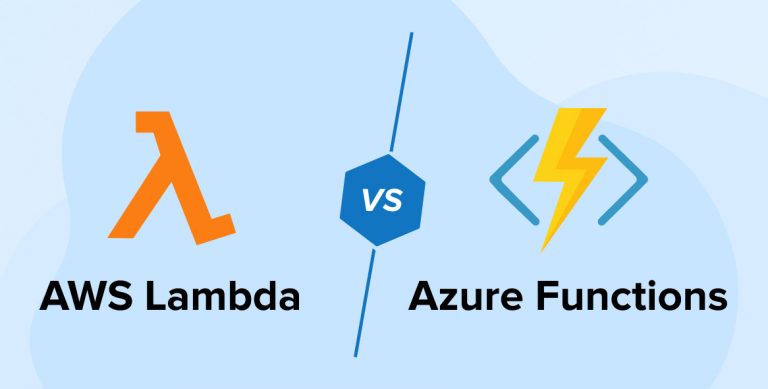
Every organization isn’t sure of which type of serverless application is the best fit for their business. For any application, it is very essential to be reliable and scalable as per the changing business needs. Apart from Google Cloud functions, the two popular names are Microsoft Azure functions and Amazon AWS Lambda. These are the ultimate choices for businesses that come with their own set of advantages and perks. This blog on AWS Lambda vs Azure Functions is intended to showcase the comparison of lambda versus azure functions. So, without much ado, let’s get started.
AWS Lambda vs Azure Functions: Parameter Comparison
Let’s compare AWS Lambda and Azure Functions in details for better understanding.
1. Code
AWS Lambda provides the support to upload the code in a zip file as well as writing the code in the console to create the function. Let us understand both ways thoroughly:
- Via ZIP File: A piece of code is deployed in the zip file as a function that is linked to a specific event like queue or HTTP endpoint which runs this function every time a matching event occurs. Users can also change the runtime associated with the function by updating the configurations. Also, developers can directly get the code from vendors which helps them consume less time.
For the code written in a non-supported language by AWS, Lambda custom runtime uses binary files which are then compiled using Amazon Linux. So, this makes things simple as there’s only one way to run code. But if there are any changes required to be implied in a code then the whole package will have to be re-uploaded. - Via Console: AWS Lambda gives good support for writing the code to create Lambda functions using the console. The benefit of using the Lambda console is that it provides a code editor for the languages which are not compiled which enables modifying and testing of the code smoothly.
Let us take a quick view of the steps of writing the lambda code through the console:- Firstly, we will need to open the Functions Page which is available on the Lambda Console.
- The next step is to create the actual function by invoking and then creating
- Then it will be followed by testing of the function wherein the user will be allowed to create up to 10 test events for each function
- It will then execute the code that has been loaded in the functions and test results will be displayed into the console.
AWS Lambda re-uses the execution environment from the previous invocation while invoking a new function if there are any available which saves time for preparing the execution environment and also allows users to save resources like the number of database connections and creation of a temporary file in the execution environment every time a function runs.
The runtime code is completely supportive of language versions diversified versions of languages. There can also be specific functions of runtime for a definite language or version of the framework which has been depreciated due to the end time it has reached.
Azure Functions code support and writing approach is a little bit complex to implement but also at the same time it is more flexible. Custom handler functions rely on HTTP primitives to communicate with code written in languages that are not supported.
Azure Functions also help in building a stable data-driven application that will allow the user to keep track of every event through a unified platform. It offers a lucid app development facility where you can integrate multiple Microsoft services like Azure Event Grid and Azure Cosmos DB etc.
This doesn’t just save time but improves efficiency too. We can simply set up the code and the deployment process using Azure functions that provide continuous support for any code-related services such as GitHub, Bitbucket, and VS Team Services. Some Logic Apps are also offered by the Azure Functions which helps in the integration without writing code.
2. Language
As you know that AWS Lambda constantly PowerShell, Node.js, Go, Python, C#, Java, and Ruby code. It facilitates a run time API which enables users to add more programming languages that can enhance their functionalities. In reciprocation of multiple events, AWS Lambda will run code automatically (i.e., HTTP requests via Amazon API Gateway, modifications to objects in Amazon S3 buckets, table updates in Amazon DynamoDB).
For choosing languages for AWS lambda mainly two factors are taken into considerations which are:
- Cold Start: The overhead in implementing any invocation of Lambda is referred to as a cold start consisting of two essential aspects. The First one is AWS, which takes time to set up an execution environment for the code of the function and is fully managed on its own. The second can be specified as the interval of code initialization which is typically handled by the developers
- Warm start: The Lambda will remain instantiated for a while soon after a cold start is made. This enables every other call to be made without initializing it every time. These calls are called the “warm call”, which means that the code is packed into memory and is ready to be executed one or more times when the Lambda function is called.
Current Azure functions runtime supports different languages like C#, JavaScript, F#, Java, PowerShell, Python, TypeScript by transpiring them to JavaScript. For every supported language, a different set of events and methods are followed to create a function. Azure does not provide Go and Ruby, else, the language options are quite the same. Language support in Azure functions comes in two levels which are as below.
- Generally available (GA): Completely supportive of all types of production use.
- Preview: There isn’t a shred of evidence to prove but can be assumed to achieve GA status in the future.
Different versions of Azure functions runtime are available as below which support differently in different versions.
| Language | 1x | 2x | 3x |
|---|---|---|---|
| C# | GA (.NET Framework 4.7) | GA (.NET Core 2.2) | GA (.NET Core 3.1) |
| JavaScript | GA (Node 6) | GA (Node 10 & 8) | GA (Node 12 & 10) Preview (Node 14) |
| F# | GA (.NET Framework 4.7) | GA (.NET Core 2.2) | GA (.NET Core 3.1) |
| Java | N/A | GA (Java 8) | GA (Java 11 & 8) |
| PowerShell | N/A | GA (PowerShell Core 6) | GA (PowerShell 7 & Core 6) |
| Python | N/A | GA (Python 3.7 & 3.6) | GA (Python 3.8, 3.7. & 3.6) |
| TypeScript | N/A | GA” | GA |
3. Function
AWS Lambda works on a simple JSON and YAML input/output model. To develop a new function, all you would need is a package for deployment that needs to be executed. After executing this function, you need to deploy Amazon CloudWatch logs to keep a track of logs and streamline AWS X-ray tracking requests.
{ "Type" : "AWS::Lambda :: Function", "Properties" : { "Code" : Code, "CodesigningConfigArn" : String, "DeadLetterConfig" : DeadLetterConfig, "Description" : String, "Environment" : Environment, "FilesystemConfigs" : { FilesystemConfig, … }, "FunctionName" : String, "Handler" : String, "Kmskey Arn" : String, "Layers" : { String, … }, "MemorySize" : Integer, "ReservedConcurrentExecutions" : Integer, "Role" : String, "Runtime" : String, "Tags" : { Tag, … }, "Timeout" : Integer, "TracingConfig" : TracingConfig, "VpcConfig" : VpcConfig } } |
{ "Type" : "AWS::Lambda :: Function", "Properties" : { "Code" : Code, "CodesigningConfigArn" : String, "DeadLetterConfig" : DeadLetterConfig, "Description" : String, "Environment" : Environment, "FilesystemConfigs" : { FilesystemConfig, … }, "FunctionName" : String, "Handler" : String, "Kmskey Arn" : String, "Layers" : { String, … }, "MemorySize" : Integer, "ReservedConcurrentExecutions" : Integer, "Role" : String, "Runtime" : String, "Tags" : { Tag, … }, "Timeout" : Integer, "TracingConfig" : TracingConfig, "VpcConfig" : VpcConfig } }
Azure Functions, you have triggers and bindings. If you use this, you can easily pull or push extra data while processing the query along with input and output bindings. These bindings are capable of offering better scalability with an extended cost of complexity in both APIs and configuration.
Enlisted are some of the most common problems that come from actual day-to-day scenarios of using Azure functions. This by no means sounds exhaustive.
| If you want to… | then… |
|---|---|
| Build a web API | Implement an endpoint for your web applications using the HTTP trigger |
| Process file uploads | Run code when a file is uploaded or changed in blob storage |
| Build a serverless workflow | Chain a series of functions together using durable functions |
| Respond to database changes | Run custom logic when a document is created or updated in Cosmos DB |
| Run scheduled tasks | Execute code at set times |
| Create reliable message queue systems | Process message queues using Queue Storage Service Bus, or Event Hubs |
| Analyze lot data streams | Collect and process data from loT devices |
| Process data in real-time | Use Functions and SignalR to respond to data at the moment |
4. Configurability
For AWS lambda deployment one needs to define maximum memory allocation approximately between 128 MB and 3 GB. The capacity of the CPU and the cost of operating the function are proportional to the memory allocated. Based on the workload profile, it takes a bit of experimenting to determine the optimum scale. All instances run on Amazon Linux irrespective of scale.
AWS Lambda provides multiple configuration options to configure function settings, to add triggers and destinations. The memory range that can be set in this function is from 128 MB to 10240 MB in 1-MB addition. The amount of time that Lambda grants for a function to run are a minimum of 3 seconds and a maximum of 900 seconds. It also allows the creation of a database proxy for the functions using the Amazon RDS DB instance pr cluster.
One size fits all- is true for all types of Azure functions. It has around 1.5GB of memory with low-profile virtual core functions. You can easily choose between different hosting platforms such as Windows and Linux. Azure Functions involves many instances to upscale their sizes for more than 14 GB and 4 vCPUs. You need to pay as per fix hour fees for reserved capacities.
Azure functions provide with consumption plan and premium plan wherein:
- The premium plan comes with multiple instance sizes up to 14 GB of memory and four vCPUs. It also encourages the limitless length of execution (60 minutes). The allocation of high-density applications for plans of different working apps is also provided by a premium plan.
- The consumption plan comes with a memory size of 1.5 GB said to be one size fits for all. It immediately scales out, even during high-load cycles. A usage schedule has little effect on each app’s durability, scalability, or reliability. As a host operating system, you can select between Windows and Linux.
5. Extensibility
Another way to simply integrate AWS Lambda with the most preferable operations of preferable alternatives for monitoring, safeguarding, and governance is a simple preview of Lambda extensions.
This post explained how Lambda extensions operate, how you should start using them, and the AWS Lambda Ready Partners extensions available today.
The extensions help to integrate the already-in action tools with the Lambda environment. There is no intricate installation or setup, and today it is easier to use favorite tools across all your portfolio of applications. With this streamlined experience, you can also imply Use-Case Extensions, such as:
- Gathering diagnostic information during the process, after the completion of function, and before that too.
- Automate the instrumentation of code without any modifications
- Lookup for configuration settings before the invocation of the function.
- Identifying and alarming functional activities through security agents who execute different processes from the function.
Extensions from AWS Lambda Ready Collaborators, AWS, and open-source projects are used. AppDynamics, Dynatrace, HashiCorp, Thundra, Lumigo, Splunk SignalFx, Datadog, Epsagon, AWS AppConfig, Check Point, New Relic, and Amazon CloudWatch Lambda Insights are available today as extensions.
If you want to create your extensions then take a deeper view into the changes made in the Lambda lifecycle post that says “Building Extensions for AWS Lambda“.
The Lambda extensions are easy to install, plugin, and used without any complexities of configuration, setups, and management. To simplify the integration of extensions from New Relic, Lumigo, and Thundra, you can use Epsagon, Stackery. You deploy extensions as Lambda layers with the AWS Management Console and AWS Command Line Interface (AWS CLI).
Code tools can also be used as infrastructure, such as AWS Serverless Application Model (AWS SAM), AWS CloudFormation, Serverless Architecture, and Terraform. You will use Stackery to simplify the incorporation of extensions from Epsagon, New Relic, Lumigo, and Thundra.
Lambda functions are performed in a sandbox environment which is called an execution environment. This is the thing that separates them from other functions. They offer them external resources such as memory-specified configuration options and more. The lambda function freezes the environment in between the subsequent invocations and functions. Utilizing the API extension, users can now manipulate and control the functions when the lambda services freeze in the execution environment.
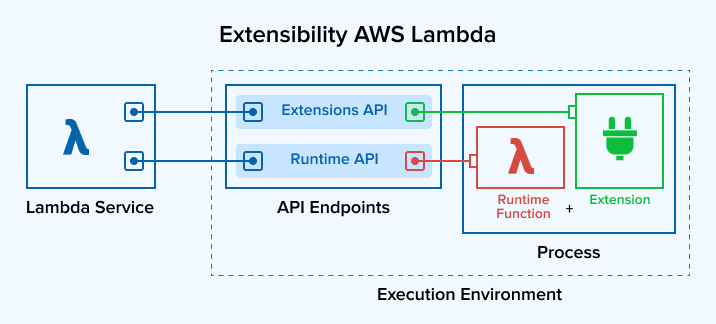
Before runtime and the feature, extensions are initialized. They then proceed to run in parallel with the function, get greater control during the invocation of the function, and during the shutdown, they will run logic.
There are various AWS Lambda Ready Partners and extensions already available at launch like AppDynamics, Datadog, Dynatrace, Epsagon, HashiCorp Vault, Lumigo, Check Point CloudGuard, New Relic, Thundra, Splunk, AWS AppConfig, Amazon CloudWatch Lambda Insights. If you want you can create your extensions and then integrate them with our in-house organization’s tools. You may also create and get your own extensions to incorporate the instrumentation of your company. For instance, the extensions used can be built using the cloud Foundations team at Square.
Starting with Azure Functions version 2.x, By default, the runtime of the function includes HTTP and time triggers and other binding and valuable information to differentiate between packages. These .NET class libraries have apps that use bindings that can be simply installed in the project using NuGet packages.
In Java, multiple app extensions allow users to use the same bindings that can explicitly install the binding extensions with no many issues regarding .NET infrastructure. The functional apps used here are JavaScript, PowerShell, python and custom handlers.
What do you mean by Extension bundle?
An extension bundle is another way to add an expandable and scalable set of binding extensions to the existing apps. You can easily enable extensions to your bundles in the app’s host.json file. There are varied versions available and each version has a specific rule set for apps to work in sync and get validated. You can select any bundle version based on the unique needs of your apps.
The table below shows how and when you should register bindings for portals to use extension bundles.
| Development environment | Registration in Functions 1.x | Registration in Functions 3.x/2.x |
|---|---|---|
| Azure portal | Automatic | Automatic* |
| Non-.NET languages | Automatic | Use extension bundles (recommended) or explicitly install extensions |
| C# class library using Visual Studio | Use NuGet tools | Use NuGet tools |
| C# class library using Visual Studio Code | N/A | Use .NET Core CLI |
6. Function Triggers & Types
Triggers in AWS Lambda are used to make functions process data automatically. It can be considered as a Lambda resource that is configured to invoke functions for every lifecycle event or external request. One function can have multiple triggers where each trigger will work as a separate and independent invocation for our function. So, each event passed to the function will have data only from the trigger or one client.
One Lambda function cannot trigger another lambda function directly in order to connect these two functions, the first event will have to generate an event for the second function in order to be triggered. For Lambda to know which event will trigger it, can be defined in the configuration section. There are other ways as well that can be triggered through this Lambda function such as:
- API Gateway event: In this just by calling API gateway lambda function will be triggered. These are the most classic events.
- S3 event: In this type of event one can specify the actions which will trigger the lambda functions. These actions can be like create, update or modify in the file specified. These contents are known as S3 bucket content which on-change triggers the function.
- DynamoDB event: In this, you will need to connect Lambda with DynamoDB which makes it a little complicated. Here DynamoDB works as a stream of line or queue which means that if there are any changes in the database then all the changes will be published instantly which will trigger a lambda function. In two different ways, a lambda can be triggered by it which is when there is any data present in the stream then at a certain time, this function will be triggered. In another way, a series of events will be present in the stream which will be executed together saving time.
You will see Azure functions are invoked by triggers. For each function, you have one trigger associated with it. The function triggers in a timely manner. How the function will be invoked and executed is defined by the triggers only. There are multitudes of triggers available for Azure functions such as:
- Queue trigger: Fires when new message arrived in Azure Storage Queue
- HTTP trigger: Fires for every HTTP request.
- Event Hub trigger: Fires for events delivered to an Azure Event Hub.
- Timer trigger: Execution time can be set using this trigger and it also can be called on a predefined schedule.
- Blob Trigger: A new blob trigger will be fired so that the contents are passed on with each input function.
- Generic Webhook: For every HTTP request coming from any services supporting webhook this trigger will be fired.
- GitHub Webhook: For any event occurring in GitHub, a trigger will be fired.
- Service Bus Trigger: Fires when a new message comes from the service bus queue.
| Example Scenario | Trigger Input Binding | Output | Binding |
|---|---|---|---|
| A new queue message arrives which runs a function to write to another queue. | Queue* | None | Queue* |
| A scheduled job reads Blob Storage contents and creates a new Cosmos DB document | Timer | Blob Storage | Cosmos DB |
| The Event Grid is used to read an image from Blob Storage and a document from Cosmos DB to send an email. | Event Grid | Blob Storage and Cosmos DB | SendGrid |
| A webhook that uses Microsoft Graph to update an Excel sheet. | HTTP | None | Microsoft Graph |
7. Scalability
Scalability plays an important role when a sudden massive workload appears. Many organizations make sure the AWS Lambda is used by both web APIs and web apps based on queues. It is also better for accelerated scale-out and large workload management. The bootstrapping delay effect – cold starts – with AWS Lambda is also less important.
AWS Lambda provides dynamic scaling applications allowing users to chain new features and also helps in incorporating custom serverless functions as a service. It also allows the user to perform external operations and a configurable timeout along with setting default action in case if it returns an error or takes more time than defined. For all incoming requests, AWS invokes and scales code automatically to support its rate without any additional configurations from your side. Due to its auto-scaling feature, the performance is as high as the rate of frequency of events and also it starts running code within a very less amount of time (milliseconds of an event).
By adding a Lambda function through SNS to the lifecycle hook, you can add to your Auto Scaling community a nearly infinite number of custom acts. Lambda can start multiple instances as required without any configuration delay and lengthy deployments as the code over here is stateless. Lambda is a more viable option for faster scale-out services and managing heavy workloads for both web API’s and queue-based applications.
In Azure Functions scaling is provided by Azure Function Scale Controller. This controller checks for all the queues in a timely manner and issues peek commands. Based on the messages received with these commands and also latencies of the same it will be deciding whether to use any additional virtual machines or not. In the case where the latencies are observed too high then a virtual machine will be added till the latency of the messages reaches the desired level.
This process will be continued regardless of the partition count of the queues. Azure Functions make sure that the services provided are always available in the case when the application requires them. And also configures applications for geo-redundancy. It makes sure that in the case when the primary program is unavailable it creates a secondary replica to avoid any major failure.
8. HTTP Triggers and Integration
Previously, AWS Lambda required an Amazon API gateway to manage HTTP traffic that costs high with some hidden charges. But now, amazon introduced integration with Load balancing that may cost high and is efficient for high load scenarios. This comes on the basis of a per-hour pricing model where you can easily judge how to exactly use it. AWS only offers C# supported by .NET Core.
The Azure functions come with exceptional and extraordinary HTTP end-point functions for integration. There are no additional expenses added to its integration in order to develop a serverless API that reacts to webhooks using an HTTP trigger.
With .NET or .NET Core runtime, Azure gives you the ability to build a feature in C#. We acknowledge that the Azure functionality has an exceptional HTTP endpoint incorporation and this does not come with an exceptional HTTP endpoint with no extra charges.
9. Identity and Access Management
The functions of AWS Lambda like IAM Access management and AWS identity constantly regulate and provide access to AWS services safely through admin. Control of IAM administrators that can be validated using signed-in options and allowed (licensed) to use Lambda services. An AWS service- IAM can be used with no added expense.
This differs in Identity and Access management that would differ as per your tasks on Lambda.
- Service user: Admins provides all the user details login, passwords and permission to run your Lambda function for your tasks. You need special permissions to do more additional tasks.
- Service Administrator: Determine which Lambda features and resources other users should access. You can submit a request to the IAM lead or admins that can help you change the approvals of service users.
- IAM admin: This allows you to draft policies and manage the accessibility in Lambda.
Authenticating with identities
Authentication can be defined as a way to identify keys, sign in into AWS. You should authenticate (signed into AWS) as the AWS account root user, as an IAM user, or as an assumer of the IAM feature. Even, you can use the company’s single sign-on authentication or even sign up for Google or Facebook.
Your administrator has already set up an identity federation using IAM roles in these instances. You owe all the user rights reserved from another company where your role is indirect.
You can use your password with a dedicated root system and user email address and your IAM user credentials. In the AWS program, you can use the root user and IAM access keys. AWS is capable of facilitating users with SDK and command-line tools to cryptographically sign requests using the rights. For cases when you don’t want to use AWS tools, you will have to assign requests on your own. For this, you can use Signature version 4 a protocol to authenticate APIs and requests.
Irrespective of the main method for authentication, you are also allowed to offer additional security data for enhanced protection. Say, for instance, AWS can recommend you to use multi-factor authentication (MFA) to improve the safeguarding of the account.
You can add the security of apps and data at the frontend by supporting Azure Functions identity and access management solutions. You can add security against various malicious logins that are risk-based with access rights, identity protection tools and more robust authentication alternatives. This should not disrupt productivity and provide multiple options that will shape best with your needs.
- If you wish to provide cloud client identity and access management, you can use Azure Active Directory External Identities to ease and maintain customer and vendor identities by providing partners, clients, people, patients or any other user outside your company with the level of customization and control provided by your business with smooth and highly secure digital experiences.
- You can easily use Azure Azure Active Directory Domain Services if you wish to facilitate clients to change domains without deploying domains using identity protection in combined machines that are virtually present in Azure. You can do this without using LDAP, Azure, Azure active directoryNTLM, Kerberos and other authentication sources.
10. Dependency Management
Talking about the runtime environment, the AWS Lambda includes a range of modules, such as the Node.js and Python runtime AWS SDK. This is aimed to manage the dependencies in the implementation bundle of your function. To allow the latest collection of features and security improvements, Lambda will regularly upgrade these libraries. These updates can incorporate subtle changes to your Lambda function’s behavior. You will have to package all the dependencies with your deployment package if you want to access all your functions from a single source.
The Azure function supports all the injection and software, designing models. With these dependencies, you can achieve the inversion of control between classes. This injection in the Azure function is created using core .NET core dependency injection features. There are multiple things common between .NET core competencies. It is highly recommended. But there is a difference in how you override dependency and how configuration values work with the consumption plan of Azure functions.
In case you want to use the dependency package, you can install all the extensions of Microsoft.Azure.Functions.Extensions and Microsoft.NET.Sdk.Functions package in version 1.0.28 or upgraded ones from NuGet packages.
11. Orchestrations
The method of configuring, administering and coordinating applications and resources automatically is known as orchestration. In the case of wider systems where manual handling and monitoring are complicated, this is primarily useful. For AWS Lambda and Azure features, let us go over how orchestration operates.
Orchestrating a series of individual AWS Lambda applications, debugging failures can be sometimes difficult. To utilize the benefit of serverless, AWS Lambda provides step functions that allow users to orchestrate invocations of the function. Step functions also provide and manage with the benefit of error handling and retry logic. This is supportive of managing the complexity of distributed systems as and when it expands.
This concept is useful mainly for executing long-running tasks. Orchestration service provided by Lambda connects the function together into serverless workflows which are generally known as state machines. When you use a function orchestrator, it will become simpler to run the lambda functions and multiple AWS services in sequence. In this flow, one can create and run the series of events where the output of one step acts as the input of the next. Each step will be executed as per the defined business logic and in order.
AWS allows the services to give a good and safer option to store information. It becomes easy and efficient to build an application with containers to know when and where it should execute. with flexible computation to pump up containers.
In Azure Functions an extension called Durable Functions is available which can be used in writing the stateful functions in a serverless environment. By using this extension workflow of the application can be defined and also orchestrator functions can be written. An orchestrator function creates the workflow without any pre-declared schemas or designs.
These functions can call other durable functions synchronously or asynchronously where the output from the functions can be stored in any local variable. The process of execution can be automatically checkpointed where the function can await or yield. These functions can run really long depending upon the requirement. Local State in between is never lost while using these functions.
The tasks which are included in the process of orchestration in azure functions are Scheduling, Health –Monitoring, Failover, Scaling, Networking, Service Discovery, Co-ordinated application upgrades.
12. Pricing
Information on costs is a retrospective aspect. After the reality of investment, the concrete figures arrive. The lack of budgeting leaves decision-makers uncertain, using them well in advance to prepare the cost of infrastructure. Therefore, our aim is to consider the cost structure and to be able to anticipate invoice shifts as apps and industry grow.
The pricing of Serverless is based on a pay-per-use model where both the services are divided based on two cost components:
- Pay-per-call
- Pay-per-GB*seconds
The second one is a metric that combines the consumed memory with execution time.
Moreover, everything was almost the same including the price tag in both the services was exactly the same. Though there were some minor differences such as:
AWS Lambda, For the maximum potential of provisioned memory. You can measure the length of the code which starts before it starts the return value or otherwise terminates the round-ups nearer 1ms* that includes test calls appearing from the console.
The charge is dependent on the total memory that you delegate within your role. You select the amount of memory you like for your role in the AWS Lambda resource model and are allocated to it. The incremental value of the memory triggers is equivalent to an increase in the availability of CPU functions. The CPU profiles are different for lambda functions and can lead to a separate duration of many comparable workloads.
Price structure- It starts from $0.20 per 1M requests and goes up to $16.67 per million GB*seconds with free service of 1 million executions and 400,000 GB-s.
The cost of duration is dependent on the memory allocated to the given functions. You can manage the memory by dividing it between 128MB and 10240 MB, in 1MB increments. The table below allows users to store smaller separate memory sizes ranging from 1ms or more memory size.
| Memory (MB) (with larger memory) | Price /1ms |
|---|---|
| 128 | $0.0000000021 |
| 512 | $0.0000000083 |
| 1024 | $0.0000000167 |
| 1536 | $0.0000000250 |
| 2048 | $0.0000000333 |
| 3072 | $0.0000000500 |
| 4096 | $0.0000000667 |
| 5120 | $0.0000000833 |
| 6144 | $0.0000001000 |
| 7168 | $0.0000001167 |
| 8192 | $0.0000001333 |
| 9216 | $0.0000001500 |
| 10240 | $0.0000001667 |
This Azure Function evaluates the average consumption of memory when executed. Executions share instances where the cost of memory is not charged multiple times when shared in between processes, leading to a major reduction. In this Consumption Plan, the bill will be dependent on resource consumption and execution per second, while in the Premium Plan, you will be billed based on v-CPU and GB-s resource consumption.
Pricing: $0.20 per 1M requests and $16.00 per million GB*seconds with the free grant of 1 million executions and 400,000 GB-s [*Free grants apply to paid, consumption subscriptions only].
Note—When you create any functions app, a storage account will be created by default which isn’t a part of the free grant. So, networking and storage rates are separately charged as peruse or as applicable.
Users can expect enhanced performance in the Azure Functions Premium plan and are charged based on the number of vCPU ($0.173 vCPU/hour) and GB ($0.0123 GB/hour) per second as per your Premium Functions consumption. The Azure function provides the ability to run functions at regular app service plans within customer’s app service plan rates.
Below is the example to compare pricing for AWS Lambda and Azure function:
Let’s assume that there is a function that observes 512 MB memory with a one-second execution duration and executes 3 million times during a month.
Below is the billing calculation of a month:
| AWS Lambda | Azure Function | |
|---|---|---|
| Resource consumption – In seconds | ||
| Executions | 3 million | 3 million |
| Execution duration | 1 second | 1 second |
| Resource consumption Total | 3 million seconds (Total: Executions * Execution duration) | 3 million seconds (Total: Executions * Execution duration) |
| Resource consumption in GB-s | ||
| Resource consumption converted to GBs | 512 MB / 1,024 MB | 512 MB / 1,024 MB |
| Execution time | 3 million seconds | 3 million seconds |
| Total GB-s | 1.5 million GB-s (Total: Resource consumption * Execution time) | 1.5 million GB-s (Total: Resource consumption * Execution time) |
| Billable resource consumption | ||
| Resource consumption | 1.5 million GB-s | 1.5 million GB-s |
| Monthly free grant | 400,000 GB-s | 400,000 GB-s |
| Total billable consumption | 1.1 million GB-s (Total: Resource consumption – Monthly free grant) | 1.1 million GB-s (Total: Resource consumption – Monthly free grant) |
| Monthly resource consumption cost | ||
| Billable resource consumption | 1.1 million GB-s | 1.1 million GB-s |
| Resource consumption price | $0.000016/GB-s | $0.00001667/GB-s |
| Total cost | $17.60 (Billable resource consumption * Resource consumption price) | $18.34 (Billable resource consumption * Resource consumption price) |
Below is an example of Executions billing calculation: [Both are the same in cost]
| AWS Lambda | Azure Function | |
|---|---|---|
| Monthly Billable executions | ||
| Total executions | 3 million executions | 3 million executions |
| Free executions | 1 million executions | 1 million executions |
| Billable executions | 2 million executions (Total: Monthly executions – Free executions) | 2 million executions (Total: Monthly executions – Free executions) |
| Monthly executions cost | ||
| Billable executions | 2 million executions | 2 million executions |
| Price per million executions | $0.20 | $0.20 |
| Execution cost per month | $0.40 (Billable executions * Price per million executions) | $0.40 (Billable executions * Price per million executions) |
Consumption Summary:
| AWS Lambda | Azure Function | |
|---|---|---|
| Total monthly cost | ||
| Resource consumption | $17.60 | $18.34 |
| Executions | $0.40 | $0.40 |
| Total | $18 | $18.74 |
Important pricing difference:
- Transfer of data among lambda and its storage is chargeable as an additional fee within a different region whereas inbound data transfers are free in Azure functions but not outbound data transfer from one datacenter to another cloud environment.
- Functions are initiated by provisioned Concurrency which is the reason for higher rates in Lambda so that they can handle requests more quickly. The cost is dependent on the functional memory and the consumption during execution time. A similar feature is also offered by Azure function in its premium plan with the addition of enhanced function performance and additional virtual networking.
13. Storage
There are multiple storage options provided by AWS Lambda to meet the needs of developers. The list of storage services includes Amazon S3 and Amazon EFS also some other storage options like temporary storage or Lambda layers available. Let us see these options in brief:
| Amazon S3 | /tmp | Lambda Layers | Amazon EFS | |
|---|---|---|---|---|
| Maximum size | Elastic | 512 MB | 50 MB (direct upload; Larger if from 53). | Elastic |
| Persistence | Durable | Ephemeral | Durable | Durable |
| Content | Dynamic | Dynamic | Static | Dynamic |
| Storage type | Object | File system | Archive | File system |
| Lambda event source integration | Native | N/A | N/A | N/A |
| Operations supported | Atomic with versioning | Any file system Operations | Immutable | Any file system operation |
| Object tagging | Y | N | N | N |
| Object metadata | Y | N | N | N |
| Pricing model | Storage + requests + data transfer | Included in Lambda | Included in Lambda | Storage + data transfer + throughput |
| Sharing/permissions Model | IAM | Function-only | IAM | IAM + NFS |
| Source for AWS Glue | Y | N | N | N |
| Source for Amazon QuickSight | Y | N | N | N |
| Relative data access speed from Lambda | Fast | Faster | Faster | Very Fast |
Azure Functions provides a storage account which is known as Azure Storage Account. Azure storage by default provides encryption of data using Microsoft-managed keys. On creating a new function app, a Storage Account should be created. Azure Storage supports Files and Table, Queue and Blob Storage. There are some storage accounts that do not provide support to queues and tables. Azure Functions depend on Azure Storage for the operations like managing triggers and logging function execution.
There are many types of Storage accounts namely Azure Premium, general-purpose and blob-only storage accounts. Which account to choose? It can be selected while creating a function app based on our existing storage account. Azure portal is used to create azure storage for azure functions. To get a good performance result it is advised that the azure function app and azure storage account must be present in the same region. You can share the same storage account with multiple functional apps but it is advised to keep individual storage accounts and individual functional apps to get better performance. Especially when durable functions and Event-Hub triggers are used in function apps one should always create separate storage.
14. Performance
1. Cold Start
Instances of cloud functions work on demand dynamically so whenever a first request is handled by any new instance, the response time increases, which is known as a cold start. After the deployment whenever the first request comes in, the first cold start happens. The moment that request is processed which can be used to make the function active and reuse it in further processes. In the case of both these AWS Lambda and Azure Function, they consist of warm instances to avoid cold start in premium and dedicated plans.
AWS Lambda
About recycling an Idea instance, AWS has the policies of a fixed 10 minutes period. If you compare the cold start difference between new and existing instances, it was moreover the same.
Azure Function
Azure has the policies to recycle an idle instance after mostly 20 Minutes. In Azure function 1.5 GB memory allocates on new instances so medium cold start latency seems high despite AWS lambda.
2. Concurrency and Isolation
Both the functionalities of AWS Lambda and Azure services are capable of executing multiple executions of the same function concurrently. And among these, each one has an incoming event to be handled.
AWS Lambda
The performance is constant and completely predictable as each execution is unique with a distinct pool of memories and CPU cycles. For each execution, it always keeps a different instance for each execution.
Azure Function
Azure Functions has the ability to allocate multiple simultaneous executions to the same virtual node, so you can’t predict the performance entirely and also, it’s not stable. As an example, if one execution is waiting for a response and idea in a queue, at the same time some other execution may use resources, otherwise be wasted. In some of the cases, executions that are starving for the resources might harm the overall processing time and/or performance by fighting for the pool in a shared environment.
15. Deployment
AWS Lambda has the ability to deploy all the functions on servers in the Lambda environment that can run on Amazon Linux. With this lambda function, users can interact with all other services on AWS cloud and other options but if we talk about deployment then it is limited to just Lambda service.
The deployment in the Azure function seems quite scalable and users can either run software internally within Docker and containers with deployed code options on Azure functional services. This enables programmers to take more control of the execution of the environment. By integrating with Kubernetes, event-driven auto-scaling is performed and the packaged functions are easily deployed to Kubernetes.
Users can deploy Azure Functions to either Linux or Windows servers. In general, the host operating system should not make a difference but if your functions have any other dependencies or any code specific to any OS, (i.e. For most programming languages and other libraries that run only on specific OS) it is quite an important factor.)
16. Examples
Following are the case studies of AWS Lambda:
- Netflix – You will find lot of AWS lambda use cases and among them Netflix is the world’s leading Internet television network that also uses AWS Lambda. The storage, numerous customers, fast processing, and high-quality is based on the fast AWS system. “From years of managing a sophisticated and dynamic infrastructure, we’re excited by AWS Lambda and the prospect of an evolution in the way we build and manage our applications,” said Neil Hunt, Chief Product Officer, Netflix. “From easier media transcoding and faster monitoring, from disaster recovery to improved security and compliance, AWS Lambda promises to help us develop dynamic event-driven computing patterns.”
- The Seattle Times – It’s a family-owned news media business serving the Pacific Northwest built on AWS Lambda. The Seattle Times has so many awards in its bucket. Seattletimes.com attracts so many visitors per month (in millions), by standing as the biggest local digital network. Here are some more details on this.
- Financial Engines – Offers investment and finance tips. AWS Lambda helps to increase processing speed and especially handling requests rate which is up to 60,000 per minute.
Following are the case studies of the Azure Functions:
- Fujifilm – FUJIFILM Software got a great outcome by moving its popular service (image file management and sharing) to the Azure platform. It delivers customer satisfaction beyond high reliability and lower latency.
- Relativity- The company enhanced its performance by creating a monitoring solution using the Azure function which helps to identify and resolve performance issues.
What to Choose between AWS Lambda and Azure Function?
Here are several benefits that AWS Lambda and Azure Functions provide, which could assist you in making a more straightforward decision.
Common Advantages:
- No infrastructure
- Pay only when invoked
- No deploy, no server, great sleep
- Easy to deploy
Advantages of AWS Lambda:
- Cheap
- Quick
- Stateless
- Extensive API
- Event-Driven Governance
- Autoscale and cost-effective
- VPC Support
- Integrated with various AWS services
- Better graphical view
Advantages of Azure Function:
- Great developer experience for C#
- Multiple languages supported
- Great debugging support
- Easy Scalability
- Can be used as a lightweight HTTPS service
- Azure component events for Storage, services, etc
- Event-driven
- Webhooks
It is quite clear from a comparison between Azure Functions vs AWS Lambda that serverless computing empowers customers to build applications at a higher pace and a lower cost. It doesn’t count which approach you take up. It was also possible to ship the designs even sooner and with lesser glitches. Compared to other conventional client-server strategies, it aims to save the corporate initiative but is not without its own individual characteristics.
Hence for both types, a Linux-based platform like AWS Lambda or windows suit like Microsoft Azure. It is vital for businesses to have an in-depth understanding of server-side software and business logic. The most considerable benefit of serverless development is that it adds slight revisions, with no effort in the code you write. One service can be scalable compared to another with minor modifications in input/output.
AWS Lambda and Azure Functions are identical services, but the downside is in the specifics and nearly every angle reveals some important differences between the two. Hence you can say that there is no ‘good way’ or’ bad way’ to handle these FaaS suppliers. The differences in the article are not exhaustive as it covers everything in detail, each aspect would require a separate article. It’s doubtful that your options will drive your best results.
It does not matter what you want to choose until you decide to go and choose something different from AWS and Azure. You’ll be reaping the benefits of a hyper scalable cloud architecture that can meet the growing needs of the businesses.
You might feel challenged while selecting a serverless solution which might not be fruitful at once. Some of the factors while choosing to include your budget, project and time frame to which the provider stands still.
As a conclusion, choose the best suitable option!
Scaling Face-Off
To compare scaling of both the cloud technologies we rent some scripts individually and record some IO to demonstrate.
Plan Details:
Azure: Consumption plan
AWS: Free Tier plan
Integration:
Azure: Created one azure function app with request type HTTP Trigger
AWS: Created one Lambda function and called via API Gateway
Function Details:
Language: .net core 3.1
Response: long dynamic string as an output (700+ characters)
The function consists of small and complex compute code which returns a long dynamic string as an output (700+ characters) and you run this script from JMeter on random time interval with 800 users and results are as below with the configuration details:
Environment Details:
Internet Bandwidth:
Download: 75.75 Mbps
Upload: 76.32 Mbps
JMeter Configurations:
Number of PCs: 3 (1 Master (Server) and 2 Slave Machines)
PCs Configurations: Core I5, 8 GB RAM (All of 3)
Function Hit Type: Uniform Random Timer
Random delay maximum: 3000 ms
Constant delay offset: 300 ms
Number of Threads (Users): 800
- 400 Threads each
- Single Slave machine can hit 400 Users in 60 seconds
- So, 2 Slave machines can hit 800 users in 60 seconds
Ramp-Up Period: 60 second
Number of Hits: 800 (1 hit per user)
Comparison Details From JMeter
Aggregate Report
- Azure

- AWS

- As you can see, the error % is 1.1which is ultimately 9. So, 9 hits failed among 800.
Aggregate Graph
- With Add Details (Azure):
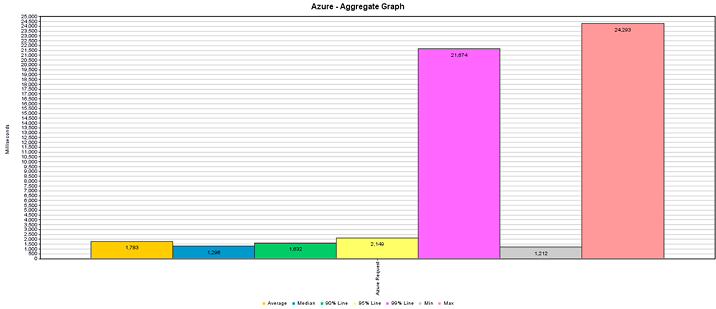
- With Add Details (AWS):
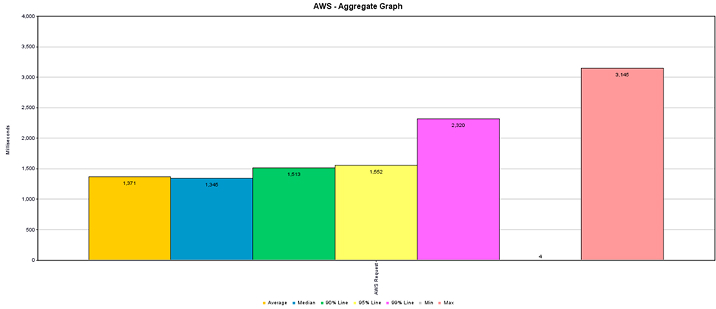
- Average (Azure):

- AWS:

Response Time Graph
- Azure:
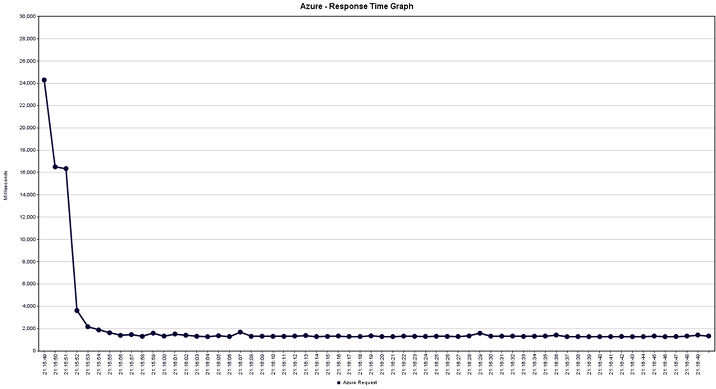
- AWS:
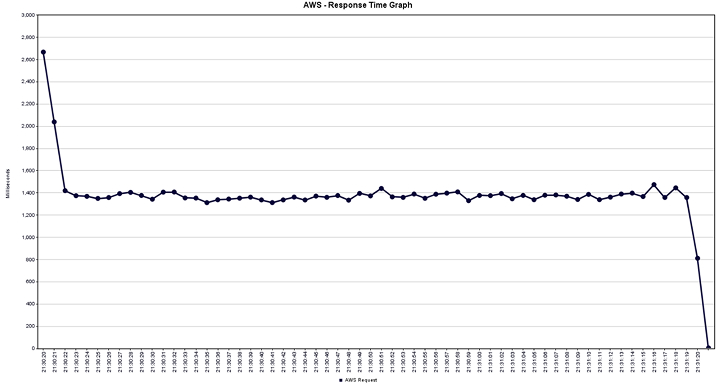
Graph Results
- Azure:
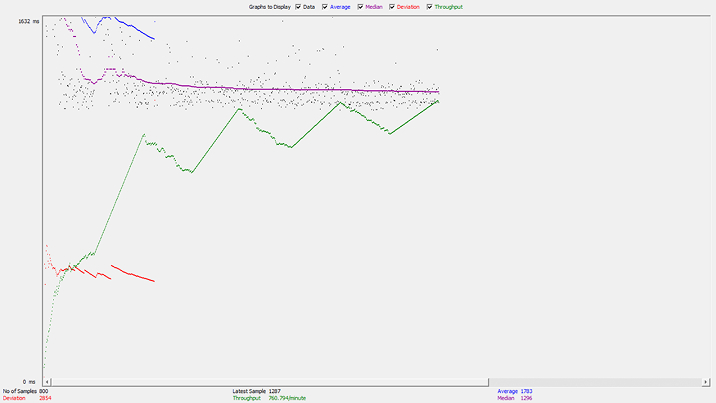
- AWS:
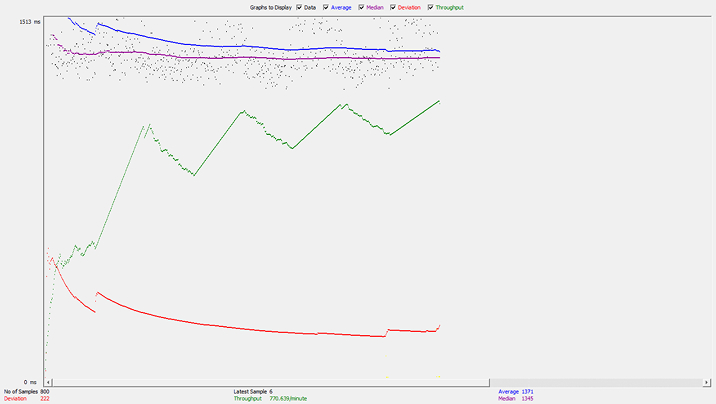
Portal Comparisons
- Azure
- Total 800 requests
- Average duration: 68.8 ms

- AWS
- Total 800 Requests among 9 are failed same mentioned in JMeter response.

- Failed requests

- Total 800 Requests among 9 are failed same mentioned in JMeter response.
Duration
- Azure
- Total Average Duration (Aggregated duration for an entry, calculated by average or 50th / 95th / 99th percentile). The average is 68.8 ms.

- Graph including 50th / 95th / 99th percentile

- Total Average Duration (Aggregated duration for an entry, calculated by average or 50th / 95th / 99th percentile). The average is 68.8 ms.
- AWS
- Total Average Duration (Aggregated duration for an entry, calculated by average or 50th / 95th / 99th percentile). The average is 30.7 ms.

- Maximum Duration: 415.46, Duration Average: 30.68, Minimum Duration: 2.43

- Total Average Duration (Aggregated duration for an entry, calculated by average or 50th / 95th / 99th percentile). The average is 30.7 ms.
Matrix Comparison
- Azure

- AWS

| Final States | Azure | AWS |
|---|---|---|
| User Load | 800 users | 800 users |
| Random delay maximum(ms) | 3000 | 3000 |
| Constant delay offset (ms) | 300 | 300 |
| Passed Requests | 100% (800) | 98.9% (791) |
| Failed Requests | 0% | 1.1% (9) |
| Avg Response Time (ms) | 68.8 | 30.7 |
Conclusion
In this extensive blog post, We have tried to cover all the aspects that are essential and dominating while we compare lambda vs azure. This blog will help developers from any software development company to find an ideal serverless computing application. If your business or team of developers are not sure of any serverless platform or service, this one will be a saving grace. We have considered all the scenarios, and functions, it is quite visible that AWS Lambda seems faster than the Microsoft Azure functions.
FAQs
Is Azure Functions Equivalent to AWS Lambda?
When it comes to comparing Azure Functions and AWS Lambda, generally these platforms tend to serve the same purpose. This means it is easy to say that AWS lambda is similar to Azure. But this is not the case for each and everything, there are some things that might differ as per the usage and project it is used for. Having said that, both these platforms have the capability to serve both remote and local testing.
What is the Difference between AWS Function and AWS Lambda?
One major difference between AWS functions and AWS Lambda is that Lambda supports unlimited functions per project. This means that it will enable a developer to have 1000 executions per account. On the other hand, AWS Functions offers 1000 functions per project but only with 400 executions.
How do I Migrate AWS Lambda to Azure Functions?
First of all, you will have to make use of the core tools of the cross-platform Azure Functions in order to create a local functions project. Then you’ll have to run the project. After that use the cross-platform Visual Studio Code to create and debug the entire project. Later implement the fully migrated function to deploy it directly from Visual Studio Code.

Vishal Shah
Vishal Shah has an extensive understanding of multiple application development frameworks and holds an upper hand with newer trends in order to strive and thrive in the dynamic market. He has nurtured his managerial growth in both technical and business aspects and gives his expertise through his blog posts.
Related Service
Custom Software Development
Know more about our Custom Software Development Service
Learn MoreSubscribe to our Newsletter
Signup for our newsletter and join 2700+ global business executives and technology experts to receive handpicked industry insights and latest news
Build your Team
Want to Hire Skilled Developers?

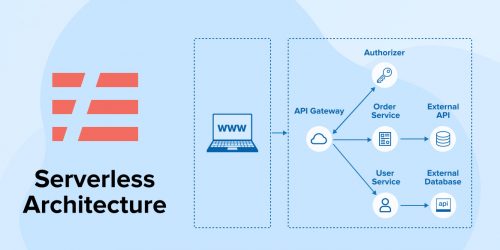
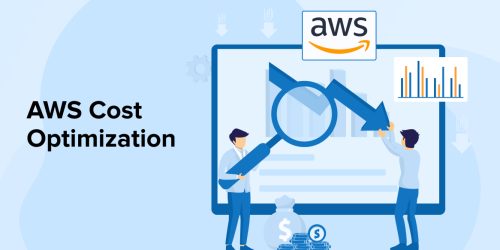


As a programmer working with serverless architecture, I really appreciate the insights provided here. The deep comparison between AWS Lambda and Azure Functions helped me gain a better understanding of the benefits and drawbacks of each platform. Thanks for the fantastic article!
AWS lambda seems to be leading the serverless computing providers list. But, what it provides different from competitors is that it does not charge any base cost for hosting your code and changes only the time when your code is executed. Whereas other service providers charge for the baseline hosting with a tiered proposition of computational power.
Not too long ago, to develop an app there was a need of having access to high-end software infrastructure consequently it was a costly, time-consuming, and complicated process. The development of cloud commuting allowed businesses to develop apps with simpler infrastructure and helped in getting the overall cost of app development lower than ever before.
Azure functions is portable which allows developers to run their serverless applications on any platform and from your network to any other cloud services.
If you’re searching for a serverless architecture that has easy to use and along with that it is also browser based, then the best option to choose would be azure functions. As it allows you to use your prefer development tool.
The main reason behind individuals and business choosing AWS over other cloud providers is that with AWS one can build various serverless back-end services including Mobile applications, third-party apps, Internet of things and websites.
There is certainly no doubt that serverless computing is the future of development. But why developers are preferring it? Well its so because it offers extra room for installing the codes without having to worry about the tools and different servers.
One of the major advantages that people can utilise when choosing AWS Lambda over other serverless solutions is that you can integrate Lambda with other AWS services. This can be very helpful to you.
Aws lambda and Azure functions both are rapidly improving their performance and scalability. Both services can handle huge workloads without any difficulties. Azure has also improved its services but still it is only trying to catch up with the industry standards.
Why is serverless like by startups and MNC’s?
Serverless is more preferred due to reasons like: 1. Lower cost. 2. Better customer satisfaction as more time is allocated towards building UX rather than infrastructure management, 3. Easily scalable, 4. Improves the user management as serverless has architecture on global scale.
It is said that in today’s time if your business is not online, your chances of survival are lesser, as everything around is moving online. Why not the same for infrastructure, looking at these needs, Serverless computing platforms were introduced. And it helped in increasing productivity because now people could focus on core work rather than managing their infrastructure.
I personally like the features of Pay only for your usage & not having to manage complicated infrastructure which FaaS (Function As A Service) offers. It is not something that traditional infrastructure could offer.
Not too long ago people and businesses had to worry about maintaining virtual machines and pay higher prices for getting the best hardware. Not any more today most of the businesses have shifted to serverless compute which offers them unlimited scaling options and higher uptime.
The thing that I like the most about Azure is with the help of it you can link your on-premise application with a web application. Now what happens is you can access all the resources inside your host-based network which otherwise may be difficult to obtain.
What is the feature of Patch Management that Azure offers?
What are the Benefits of using Azure Functions?
Azure functions provide a number of advantages, including support for a variety of programming languages, deeper interaction with toolkits, and continuous deployment. It's also compatible with other Azure services.
What is Webhooks?
It is a light Application programming interface that powers only one-sided communication of information This API is driven by events rather than requests.
Let us assume due to some reason your application gets a lot of server requests and gets overloaded which will create some issues in working. This was the case happening in earlier traditional cloud services. In Azure serverless, the application scales automatically. It can automatically take in any sudden spike.
How is Auto-scaling of AWS Lambda helpful in comparison to traditional cloud services?
Reasons to choose Azure are as follows: -Azure can help in reducing the cost as you only pay as per the resources you use. -It has an easy learning curve so new developers can easily adapt. -Easy scalability, if you are a firm that works on multiple projects and your team size keeps on changing this would be the most useful feature as it can scale from 10 to 10 million without changing the code structure.
Why should you choose Microsoft Azure for your development project?
Here is the list of companies using AWS Lambda: Robot, Netflix, The Guardian, Alameda county, Alt/s, AOL, Autodesk, Benchling, Blissfully, BMC, Bustle, CustomInk.
Which all companies are using AWS Lambda?
Can anyone help me in understanding what are the advantages of Serverless computing?
Here are some of the benefits of using serverless computing - the first and foremost is no management of server, - cost effective because you only need to pay for the space that you are using, - they are scalable as per your usage because it allocates the resources as per the needs, - Easy deployment and quicker updates of patches, - New features addition continuously - server response time is faster
Common use cases of AWS Lambda: you can create a server-less website, facilitating multi location media modification, supports the functioning of Alexa, it can provide you real time data on metrics and analysis, and helps in creating a custom mobile application.
AWS Lambda is one of my favorite serverless platform and will suggest you to go for it. Because it has got one of the best feature of pay only for that much you use. AWS Lambda runs your code automatically in response to multiple events from various sources. It can run the code within or outside AWS Ecosystem. It can even integrate with other Amazon web services seamlessly thereby helping developers in creating large secure and cost-effective applications in the cloud.
AWS Lambda supports PowerShell, Node, Python, C# and Go, natively also provides you a Runtime Application programming interface (API) that lets you access any other programming language.
Hey, I wanted to know which languages are supported by AWS lambda?